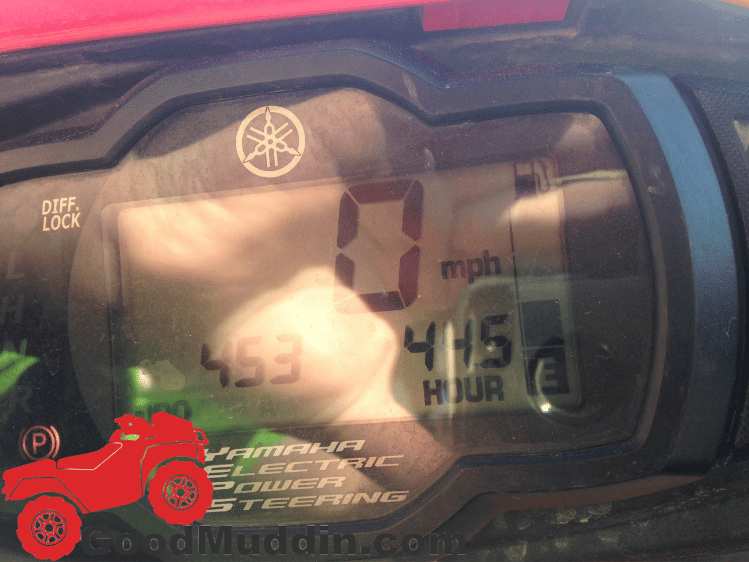Mileage = is how many miles the machine has traveled.
Hours = is how many hours the engine has been running.
Why the separation? The reason for the separation is to give us a better understanding of how the ATV is used. A model with HIGH mileage with low hours means they drove the thing fast. LOW mileage and high hours means they used the ATV as a workhorse.
If you ask me, the hours matter more than the miles.
The engine of an ATV is more important and tells me how much more life I can get out of it. All I’m saying, engine and its parts are more expensive and harder to deal with than the parts that rely on miles.
Replacing tires, ball joints, CVT boots and everything else that go off miles are just normal costs of an ATV, things I expect to replace every so often.
But replacing the timing chain after so many hours is more involved and should be done after so many hours.
So, I put more weight on the hours than the miles.
If you’re wondering how long ATVs last, then we have a post here that answers that question.
How Hours Are Calculated
The hours on an ATV are calculated when the engine is running.
Some older models may have the hour meter running with the key is left on, but most modern ones don’t start counting until the RPMs are over zero.
Either way, it’s a good idea to remove the key when you’re done riding it, as leaving the key on will kill the battery.
Many Can-Am’s will shut the gauge off after a few minutes of inactivity with the key on, which also stops the hour meter. But if you have accessories going that keep the gauge alive, it will still count the hours.
You may run into dealerships that have used, and even new/DEMO models with high hours sitting outside. It’s common for us to start the ATVs, especially on cold days, and let them sit for 10 minutes before bringing them in for the day. Starting the ATV and going off right away is not good when you do it every day until the thing was sold, so we made it a habit to let them idle for a bit as changing plugs was annoying. So, these new and used ATVs would tend to get higher hours, but they were also baby more because of this, so it’s something to keep in mind when buying from a dealership.
It’s also common for people to leave their engines running while cleaning them, which affects the hour meter count. As you can see, there are numerous caveats to considering hours and miles, making them not strong enough as the sole factor for making a purchase decision.
How Are Miles Calculated
The miles on an ATV or side by side are calculated by how many rotations happen on the wheels.
The more your wheels rotate, the more it calculates the miles traveled.
Miles To Hours Ratio
You’ll see guys comparing their miles to hours ratio.
The guys who do a lot of work tend to have higher hours, like 3 miles to every 1 hour (3:1) and the guys who do a lot of trail riding tend to be the opposite, like 20 miles for every 1 hour (20:1).
These numbers can be all over the place and not something I would put too much weight on.
At the end of the day, what matters more is how well the ATV was taken care of than the hours or miles on it.
I’ve seen people never ride their ATV and the thing turn to crap from sitting, and I’ve also seen the guys who ride all the time but took care of it when they were supposed to. I rather have the machine that was taken care of than the one abandoned and left to rot.
Large Wheels Affects Mileage
Putting larger wheels on your ATV will affect the mileage that is calculated.
Larger tires mean lower miles on the odometer on your ATV! The larger the tire, the fewer rotations that are made and thus fewer miles that are calculated. Keep this in mind when buying an ATV with larger tires, as the miles will not be correct.
Many guys will swap out tires every so often, which adds to the misalignment of the correct miles.
What can’t be fooled as easy is the engine hours, as that is done by the computer and starts counting when the engine RPMs are over zero.
Engine Hours Are Stored In Multiple Places On Your ATV
I’ve had a few guys try to get smart and sell an ATV with lower hours and miles by buying a new gauge.
When you’re buying a used ATV, look at the gauge to see how new it looks so you’re not being fooled.
The funny part about this is that, for at least Can-Am, is that the hours and miles are stored in multiple places on the ATV and not just the gauge. You also need to program the gauge to the ATV on a Can-Am, so stealing is harder.
A lot of these guys are smart and figure ways around it, but when hooking up to the dealership’s computer would always rat them out. The computer reads the hours from all places and knows the real hours.
So if you’re ever in doubt about the hours of an ATV, just take it to the dealership and have them read it from their computer. You also get the service counter too, so you can see how many times they had a dealership service it.
